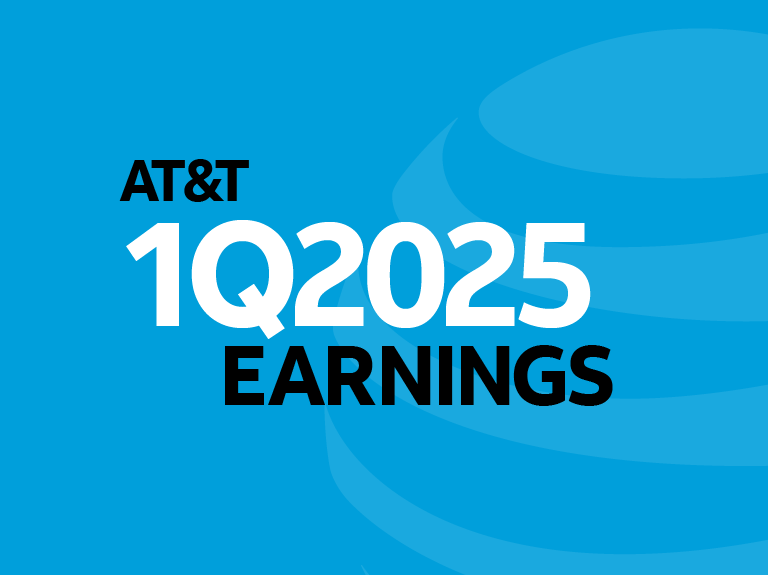AT&T Reports First-Quarter 2020 Results
First-Quarter Consolidated Results
- Diluted EPS of $0.63 as reported compared to $0.56 in the year-ago quarter
- Adjusted EPS of $0.84 ($0.89 without COVID-19 impact) compared to $0.86 in the year-ago quarter
- Cash from operations of $8.9 billion
- Capital expenditures of $5.0 billion
- Free cash flow of $3.9 billion
- Consolidated revenues of $42.8 billion
Note: AT&T's first-quarter earnings conference call will be webcast at 8:30 a.m. ET on Wednesday, April 22, 2020. The webcast and related materials will be available on AT&T’s Investor Relations website at https://investors.att.com.
AT&T Inc. (NYSE:T) reported first-quarter results that underscored the financial strength and ample liquidity of the business even with current economic conditions.
The strength and relevance of our core subscription businesses, our continued execution on our business transformation initiatives, and sizing of our operations to economic activity is expected to provide cash from operations to support investments in growth areas, dividend payments and debt retirement.
First-Quarter Highlights
Communications
- Mobility:
- Service revenues up 2.5%
- Operating income up 9.0% with EBITDA of $7.8 billion, up 7.0%
- Postpaid phone churn of 0.86%, a 6 basis point improvement
- 163,000 postpaid phone net adds1
- Named nation’s best network and, for the 5th quarter in a row, the fastest network2
- Entertainment Group:
- Solid video and broadband ARPU gains
- AT&T TV national launch; video subs impacted by focus on long-term value customer base:
- 18.6 million premium TV subscribers – 897,000 net loss
- 209,000 AT&T Fiber net adds; IP broadband revenue growth of nearly 2%
WarnerMedia
- HBO Max launch set for May 27
- Cancellation of the 2020 NCAA Division I Men's Basketball Tournament
- Warner Bros. television and film production on hiatus during pandemic
“The COVID pandemic had a 5 cents per share impact on our first quarter. Without it, the quarter was about what we expected — strong wireless numbers that covered the HBO Max investment, and produced stable EBITDA and EBITDA margins,” said Randall Stephenson, AT&T Chairman and CEO.
“We have a strong cash position, a strong balance sheet, and our core businesses are solid and continue to generate good free cash flow — even in today’s environment. In light of the pandemic’s economic impact, we’ve already adjusted our capital allocation plans and suspended all share retirements,” Stephenson said. “As a result, we’re able to continue investing in critical growth areas like 5G, broadband and HBO Max, while maintaining our dividend commitment and paying down debt.”
Consolidated Financial Results
AT&T's consolidated revenues for the first quarter totaled $42.8 billion versus $44.8 billion in the year-ago quarter. Growth in domestic wireless service revenues and strategic and managed business services revenues partially offset declines in revenues from WarnerMedia, domestic video, legacy wireline services, domestic wireless equipment and Vrio.
Operating expenses were $35.3 billion versus $37.6 billion in the year-ago quarter, down 6.1% due to a one-time spectrum gain, lower Entertainment Group costs, lower WarnerMedia costs primarily associated with lower revenues, lower domestic wireless equipment costs and cost efficiencies. Merger-amortization was stable year-over-year and includes amortization of orbital slots licenses which commenced in the current quarter.
Operating income was $7.5 billion versus $7.2 billion in the year-ago quarter, with operating expense reductions outpacing revenue declines. Operating income margin was 17.5% versus 16.1% in the year-ago quarter. When adjusting for amortization, a one-time spectrum gain, merger- and integration-related expenses and other items, operating income was $9.1 billion versus $9.6 billion in the year-ago quarter, and operating income margin was 21.2% versus 21.4% in the year-ago quarter.
First-quarter net income attributable to common stock was $4.6 billion, or $0.63 per diluted common share, versus $4.1 billion, or $0.56 per diluted common share, in the year-ago quarter. Adjusting for $0.21, which includes merger-amortization costs, a one-time spectrum gain, merger- and integration-related expenses and other items, earnings per diluted common share was $0.84 compared to an adjusted $0.86 in the year-ago quarter. The company did not adjust for COVID-19 costs of about $0.05 in the quarter, with more than half of those costs expected to have only short-term impacts.
Cash from operating activities was $8.9 billion, and capital expenditures were $5.0 billion. Capital investment – which consists of capital expenditures plus cash payments for vendor financing – totaled $5.8 billion, which includes about $800 million of cash payments for vendor financing. Free cash flow – cash from operating activities minus capital expenditures – was $3.9 billion for the quarter. Net-debt-to-adjusted EBITDA at the end of the first quarter was about 2.6x3.
In addition to its investments to further improve and expand operations, AT&T used its cash to return substantial value to shareholders through dividends and share repurchases. In the first quarter, dividends paid for common shares totaled $3.7 billion and the company repurchased 142 million of its common shares.
Guidance
Due to the lack of visibility related to COVID-19 pandemic and recovery, the Company has withdrawn financial guidance at this time.
1All subscriber counts exclude customers who we have agreed not to terminate service under the FCC’s “Keep Americans Connected Pledge”. For reporting purposes, the company counts these subscribers as if they had disconnected service
2 America’s Best Network based on GWS OneScore Sept. 2019; Nation’s fastest network based on analysis by Ookla® of Speedtest Intelligence® data median download speeds for Q1 2020. Ookla trademarks used under license and reprinted with permission.
3Net Debt to adjusted EBITDA ratios are non-GAAP financial measures that are frequently used by investors and credit rating agencies to provide relevant and useful information. Our Net Debt to Adjusted EBITDA ratio is calculated by dividing the Net Debt by the sum of the most recent four quarters Adjusted EBITDA.



